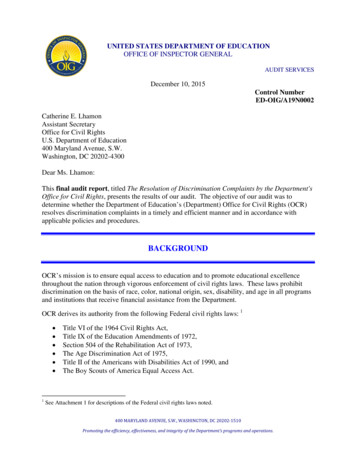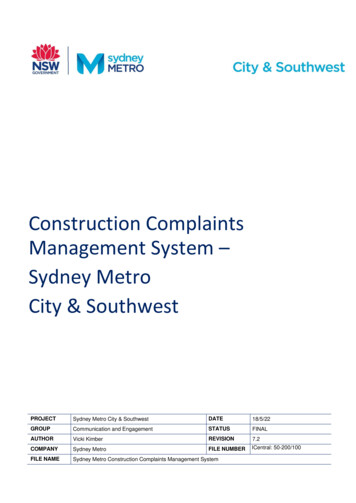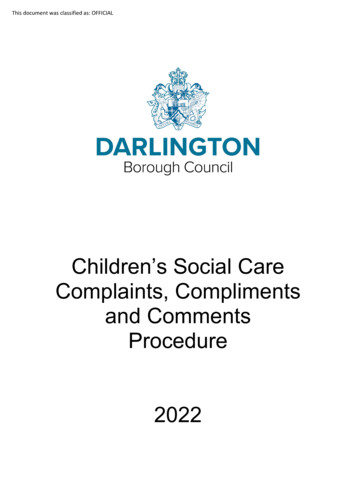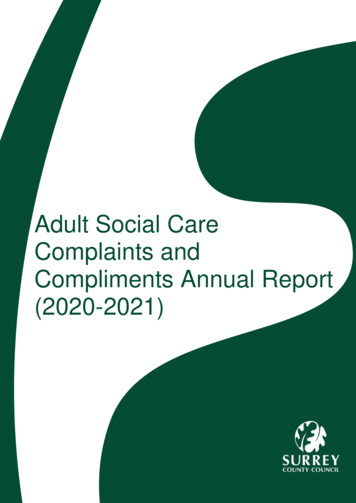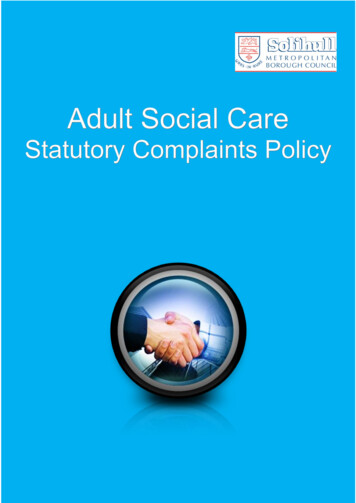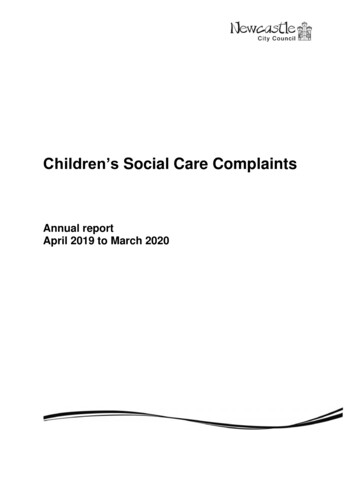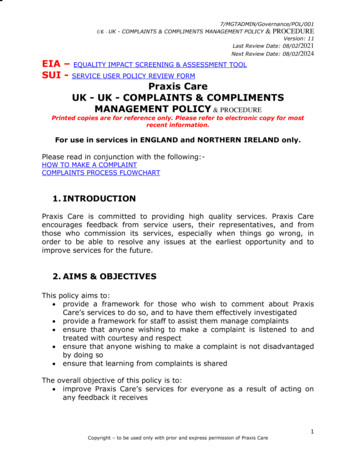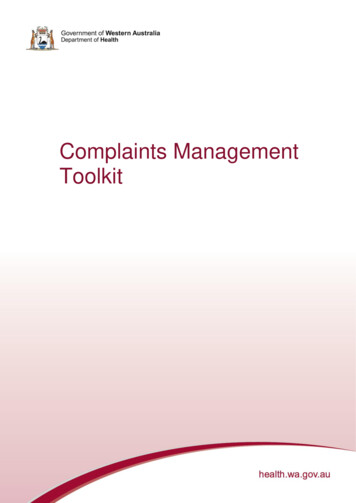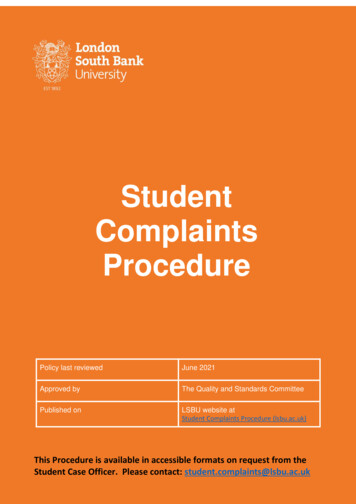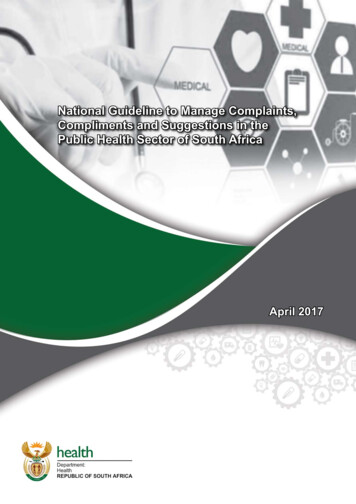
Transcription
National Guideline to Manage Complaints, Compliments and Suggestionsin the Public Health Sector of South AfricaNational Guideline to Manage Complaints,Compliments and Suggestions in thePublic Health Sector of South AfricaApril 2017
National Guideline to Manage Complaints, Compliments and Suggestionsin the Public Health Sector of South AfricaFOREWORDAs enshrined in the national Patients’ Rights Charter everyone in South Africahas the right to complain about the healthcare they receive, to have suchcomplaint investigated and to receive a full response on such investigation. Thisis enforced by Section 18 and 78 of the National Health Act of 2003 as amended.To monitor whether health facilities adhere to the Act the National Departmentof Health (NDoH), the Department of Public Service and Administration (DPSA)and the Department of Planning, Monitoring and Evaluation (DPME) have eachdeveloped a set of standards. These standards were developed to measurethe efficiency and effectiveness of health establishments to manage complaints, compliments andsuggestions to ensure that the right of patients and/or their families/support persons to complain isupheld. To this end, the National Department of Health (NDoH) has developed the National Guideline toManage Complaints, Compliments and Suggestions to assist health establishments to comply with thestandards as set out by the DPSA and DPME.This Guideline further serves as a contribution towards upholding the right to complain and use thecomplaints to inform strategies to improve the quality of health services. It aims at readily providinginformation to the public on how to complain, give a compliment or suggestion within the health sectorand what to then expect in the event of complaining. It also provides guidance to the health sectoron how to manage complaints in view of resolving them as quickly as possible, particularly throughimmediate informal responses by frontline health workers, or through subsequent investigation andconciliation by staff empowered to deal with complaints as they arise. Furthermore, it guides a processwhereby valuable information is gathered from which the health system could learn and to which it canpositively respond by bringing about the required change.The Health Ombud within the Office of Health Standards Compliance (OHSC) will also change thefuture ‘landscape’ in which complaints will be managed. To be effective and efficient, such body willrequire an efficient and effective national standardised complaints management system that can deliveron the higher demands set by the Health Ombud. Improving the overall management of complaints,compliments and suggestions at establishment, district, provincial and national level has thereforebecome imperative.3
National Guideline to Manage Complaints, Compliments and Suggestionsin the Public Health Sector of South AfricaAcknowledgmentsThis Guideline was preceded by a number of other Guidelines and a Protocol, the first National Guidelinewas published in April 2003 by the National Department of Health (NDOH). Since this first release ofthe Guideline it has been revised and released twice, i.e. in August 2006 and November 2009. TheGuideline was then revised and published as a National Protocol in August 2014. A decision to revisethe Protocol to become a National Guideline was triggered by reports from the Auditor General, DPSA,DPME and OHSC in 2015 that reported poor performance of health establishments on the managementof complaints, compliments and suggestions.Thank you to Ronel Steinhöbel for coordinating the development of the Guideline within the Directorate:Quality Assurance, as well as our colleagues in provincial quality assurance and customer care unitsthat have made continuous contributions throughout the development of the various guidelines andprotocol.A vote of thanks to the Board of the OHSC that gave inputs and approved the National ComplaintsManage Protocol that formed the corners stone from which this Guideline was developed.A special thank you to the members of the National Strategic Planning Committee, the DPSA and theDPME that also made valuable contributions to the Guideline.Lastly great appreciation tendered to the Technical Committee of the National Health Council for theirguidance throughout the process of the development and finalisation of this Guideline.The date for the next review of this Guideline is April 2022.4
National Guideline to Manage Complaints, Compliments and Suggestionsin the Public Health Sector of South AfricaTable of contents1. PURPOSE71.1 The key objectives of the health sector71.2 The key objectives of patient or their families/supporting persons82. SCOPE93. DEFINITIONS94. LEGAL AND POLICY FRAMEWORK104.1 The Constitution of the Republic of South Africa104.2 The National Health Act, Act 61 of 2003 as amended114.3 The White Paper on Transforming Public Service Delivery114.4 Public Service Legislative Framework124.5 Ethical rules for health providers124.6 The National Patients’ Rights Charter125. GUIDING PRINCIPLES125.1 Customer focus125.2 Visibility135.3 Accessibility135.4 Responsiveness135.5 Objectivity and fairness135.6 Confidentiality135.7 Remedy135.8 Review145.9 Accountability145.10 Continuous improvement146. COMPLAINT MANAGEMENT146.1 Clinical governance, complaint management and patient safety incident management 146.2 System to lodge and manage complaints156.3 Steps to effectively manage complaints186.3.1 Step 1: Enabling complaints196.3.2 Step 2: Responding to complaints196.3.3 Step 3: Accountability and learning237. COMPLIMENT AND SUGGESTION MANAGEMENT267.1 Recording a compliment or suggestion267.2 Identifying good practises and system failures (Categorisation)267.3 Compliment and suggestion Register267.4 Reporting on compliments and suggestions278. REQUIRMENTS FOR A WRITTEN STANDARD OPERATING PROCEDURE TO MANAGECOMPLAINTS, COMPLIMENTS AND SUGGESTIONS278.1 Complaints278.2 Compliments and suggestions289. IMPLEMENTATION BY COMPLAINT, COMPLIMENT AND SUGGESTION COMMITTEES 299.1 Complaint, Compliment and Suggestion Committees for Health Establishments299.1.1 Terms of Reference299.1.2 Designation of members for Community Health Care Centers and Clinics299.1.3 Designation of members for hospital CCSCs309.2 Sub-district/ district Complaint, Compliment and Suggestion Committees309.2.1 Terms of Reference309.2.2 Designation of members319.3 Provincial Complaint, Compliment and Suggestion Committees319.3.1 Terms of Reference315
National Guideline to Manage Complaints, Compliments and Suggestionsin the Public Health Sector of South Africa9.3.2 Designation of members9.4 National Complaint, Compliment and Suggestion Committee9.4.1 Terms of Reference9.4.2 Designation of membersList of annexuresAnnexure A: Form to lodge a complaint or record a compliment or suggestionAnnexure B: Specifications for complaint, compliment and suggestion boxesAnnexure C: Poster to inform patients or families/support persons on the process tofollow to lodge a complaint or record a compliment or suggestionAnnexure D: Categories for complaints, compliments or suggestionsAnnexure E: Register for complaintsAnnexure F: Summary form on outcome of complaint investigationAnnexure G: Statistical data on complaintsAnnexure H: Compliment RegisterAnnexure I: Suggestion registerAnnexure J: Statistical data on complimentsAnnexure K: Statistical data on suggestions323232323334353637384041414243List of figuresFigure 1: Four key pillars of Clinical GovernanceFigure 2: Flow diagram of a three-stage system to manage complaintsFigure 3: Flow diagram to illustrate the allocation of the number of days to resolvecomplaints at establishment and district/provincial levelFigure 4: Flow diagram to illustrate how the guiding principles of complaint managementforms the three steps for managing complaints effectivelyFigure 5: Flow diagram of complaint management process1826List of tablesTable 1: Calculation of indicators for complaints246141616
National Guideline to Manage Complaints, Compliments and Suggestionsin the Public Health Sector of South Africa1. PURPOSEThe purpose of the National Guideline to Manage Complaints, Compliments and Suggestions is to providedirection to the health sector of South Africa regarding the management of complaints, compliments andsuggestions by ensuring that standards and measures as set out by the National Department of Health, theDepartment of Planning, Monitoring and Evaluation in the Presidency and the Department of Public Serviceand Administration are adhered to.This Guideline gives guidance to ensure that the right of patients and/or their families/support persons tocomplain is upheld. This is achieved by setting out processes to ensure that patients/families and supportpersons are informed on how to lodge a complaint or record a compliment or suggestion and on what tosubsequently expect.Furthermore, it guides a process whereby valuable information is gathered from which the health systemcould learn and to which it can positively respond by bringing about the required change to improve quality.In setting up a Guideline to manage complaints, compliments and suggestions, the perspective of the patientor their families/supporting persons and the health sector has been considered, i.e. the health sector shouldbe clear on why it needs a guidelines and it should be understood why patients or their families/supportingpersons make their grievances known.1.1 The key objectives of the health sectorThe health sector would like to attain the following key objectives through this Guideline: To respect the patient’s right to complain or give compliments/suggestions: Rights are thecornerstone of any democracy. Constitutionally, all South Africans have the right to health care servicesand legally they may complain or give compliments/suggestions about the manner in which theseservices are provided to them. The health sector should therefore respect, protect, promote, and fulfillthis right to complain or give compliments/suggestions, and not revert to any form of victimisation. To resolve problems and satisfy the concerns of the patient or their families/supportingpersons: Concerns of patient or their families/supporting persons should always be taken seriously.The actions needed to address a complaint should always be geared towards resolving the problem.To provide a simple complaints, compliments and suggestions procedure everybody canunderstand: All the steps of the procedure should be clearly documented and should be made knownto the public through various means of communication, for example pamphlets, brochures and posters 7
National Guideline to Manage Complaints, Compliments and Suggestionsin the Public Health Sector of South Africa in the appropriate languages.To provide health service managers with a means to extract lessons on quality and tosubsequently improve services for patients: Complaints and compliments/suggestions should berecorded and classified in such a manner that they can be easily analysed, trends identified andlessons drawn from the information at hand.To ensure fairness for staff and patients alike: When complaints are investigated, the views,opinions, experiences and observations of all concerned should be objectively obtained and assessedwithout any prejudice.To strive for honesty and thoroughness: Investigatory processes when instituted should promotethoroughness and not protect the health establishment or staff’s own interest at the expense of thepatient’s autonomy and interest.To avoid unnecessary litigation: Long delays in resolving complaints often lead to great frustrationand to subsequent litigation. Unnecessary litigation as a means to resolve a complaint is not costeffective, thus innovative ways of avoiding such cases should at all times be sought.To build staff moral: Compliments encourage staff to perform better and also give recognition to staffthat excel in their work environment.1.2 The key objectives of patient or their families/supporting personsPatient or their families/supporting persons may have a variety of objectives when making their grievancesknown. These objectives need to be at least partially met during redress if the patient or their families/supporting persons are to be satisfied with the response he or she receives. These objectives can be oneor more of the following: To get acknowledgement: The patient or their families/supporting persons’ views should betaken seriously. The mere fact that they had reason to complain or give a suggestion should beacknowledged. To receive an apology: As a simple apology can be a very important objective for patients ortheir families/supporting persons that lodged a complaint. Such an apology, if warranted, shouldbe given without too long a delay. To receive an explanation: Information on what happened and why it happened needs to beprovided to the patient or their families/supporting persons once a complaint is lodged. Thisshould be done in a language he/she understands. The explanation should not deny the patientor their families/supporting persons’ experience of events and it should not degenerate into aform of making excuses. To prevent recurrence: People often complain and make suggestions in an altruistic manner toensure something is done to prevent their (bad) experience happening to others as well. Getting8
National Guideline to Manage Complaints, Compliments and Suggestionsin the Public Health Sector of South Africaa commitment to action in this regard becomes the main objective. This commitment should begiven and conveyed to the patient or their families/supporting persons, and all actions committedto should be carried through. To ask for compensation or special consideration: Often patients or their families/supportingpersons that lodge a complaint want action to take place that has a more direct bearing on eithertheir own care or the care received by the patient on whose behalf they are complaining. Thismay include preferential or additional treatment, or even financial compensation. To seek retribution: Although seeking retribution is rather the exception than the rule, in somecases the patient or their families/supporting persons does want steps to be taken againstindividual health workers/health establishments for their ‘alleged’ wrongful actions or where theyfeel there is a cover-up of mistakes. To give recognition to staff that provided excellent service: The patient or their families/supporting persons wants to convey their gratitude over to staff that provided a good service bygiving them a compliment to show their appreciation for the care that was provided.2. SCOPEThis Guideline is applicable to all staff working in health care establishments in South Africa.The Guideline: applies to all complaints, compliments and suggestions that are lodged in health establishmentsof South Africa, is applicable to clinical staff and non-clinical staff, describes roles and responsibilities in the management process of complaints, compliments andsuggestions, defines the timeframes within which complaints and the results of the investigation of thesecomplaints, are to be reported and redress provided to patients and/or their families/supportpersons, and identifies the facility/district/provincial and national level processes for aggregation, analysis,learning and action on complaints, compliments and suggestions.3. DEFINITIONSComplaintA complaint is defined as the dissatisfaction, displeasure, disapproval or discontent expressed verballyor in writing by any person about the specific health services being rendered and or care being provided9
National Guideline to Manage Complaints, Compliments and Suggestionsin the Public Health Sector of South Africawithin the health sector.The complaints procedure as described in this Guideline has not been designed to address the following: staff–specific grievances that is codified within labour relations legislation and can thus be addressedthrough labour relations processes, complaints that relate more to broad national health policies, for example the placement and building ofnew health facilities, the drug regimens for the treatment of specific diseases or disapprovals expressedtowards legislation falling under the Portfolio Responsibilities of the Minister of Health, e.g. the Choiceon Termination of Pregnancy Act 1996 (Act 92 of 1996) and the Tobacco Products Control AmendmentAct 2015 (Bill 14 of 2015) and complaints that relate to corruption which should be referred to the National Anti- Corruption Hotline(NACH).ComplimentA compliment is any expression of praise, commendation or admiration given by any person on healthservices being rendered and or care being provided within the health sector.SuggestionA suggestion is any proposal made or an idea that has been put forth by any person to improve the healthservices being rendered and or care being provided within the health sector.4. LEGAL AND POLICY FRAMEWORKThe constitutional, legislative and policy framework for the guideline is as follows:4.1 The Constitution of the Republic of South Africa, 1996 (Act 108 of 1996)Chapter 2 of the Constitution1, i.e. the Bill of Rights, bestow citizens inter alia the right to have their dignityrespected and protected, to take action against the State if they believe their constitutional rights havebeen infringed, and to have access to information held by the State which they need in order to be able totake action.1. Constitution of the Republic of South Africa, Government of the Republic of South Africa. Act 108 of 199610
National Guideline to Manage Complaints, Compliments and Suggestionsin the Public Health Sector of South Africa4.2 The National Health Act 2003 (Act 61 of 2003 as amended)Section 18 of the National Health Act2 states that, (i) any person may lay a complaint about the manner inwhich he or she was treated at a health establishment and have the complaint investigated, (ii) the relevantMember of the Executive Council [MEC] and every municipal council should establish a procedure for thelaying of complaints within those areas of the national health system for which they are responsible, and(iii) in laying the complaint, the person or user referred to above should follow the procedure establishedby the relevant MEC or the relevant municipal council, as the case may be. Section 18 also states that theprocedure for laying complaints should, (a) be displayed by all health establishments in a manner that isvisible for any person entering the establishment and the procedure should be communicated to users on aregular basis, (b) include provisions for the acceptance and acknowledgement of every complaint directedto a health establishment, whether or not it falls within the jurisdiction or authority of that establishment,and (c) allow for the referral of any complaint that is not within the jurisdiction or authority of the healthestablishment to the appropriate body or of2013(Act12of2013)3states that the objectives of the Office of Health Standards Compliance is to protect and promote the healthand safety of users of health services by inter alia ensuring consideration, investigation and disposal ofcomplaints relating to non-compliance with prescribes norms and standards in a procedurally fair, economicaland expeditious manner. The standards as set out in the National Core Standards for Health Establishments4are structured into seven cross-cutting domains. The various standards relating to complaints, complimentsand suggestions are set out in domain 1 (Patient Rights). The said Act also states in Section 81A (1) thatthe Ombud (within the said Office) may, on receipt of a written or verbal complaint relating to normsand standards, on his or her own initiative, consider, investigate and dispose of the complaint in a fair,economical and expeditious manner4.3 The White Paper on Transforming Public Service DeliveryThe White Paper on Transforming Public Service Delivery5 (the Batho Pele White Paper) states itunequivocally as a principle that if a promised standard of service is not delivered, citizens should beoffered an apology, a full explanation and a speedy and effective remedy. Furthermore, when complaintsare made, citizens should receive a sympathetic, positive response. In section 4.7 of the White Paper clearguidance on remedying mistakes and failures are provided to national and provincial departments.2. National Health Act, Act 61 of 20033. The National Health Amendment Act, Act 12 of 20134. National Core Standards for Health Establishments in South Africa, DOH 20115. The White Paper on Transforming Public Service Delivery, Department of Public Service and Administration Notice 1459 of 199711
National Guideline to Manage Complaints, Compliments and Suggestionsin the Public Health Sector of South Africa4.4 Public Service Legislative FrameworkIn terms of the Public Service Regulations, 2001 (based on the Public Service Act, 1994 asamended), an executive authority shall establish and sustain a service delivery improvementprogramme (SDIP) for her or his department. One of the key elements of the service deliveryimprovement programme (as per the regulations), is that it should stipulate a system or mechanismfor (managing) complaints and compliments. To assist departments in developing their complaints/compliments management systems, the Department of Public Service and Administration (DPSA)developed the Citizen Complaints and Compliments Management Framework in March 2013.64.5 Ethical rules for health providersAll health professionals are bound by ethical rules in their specific professional practice. As the gist ofthese rules has to do with the protection of their patients and the public at large, health professionals arethus held accountable for their professional acts and omissions. The ethical rules guide judgment againstunethical practices of health professionals. Public health workers are subject to the Code of Conduct forPublic Servants in which the expected relationship of the employee with the public is clearly defined.4.6 The National Patients’ Rights CharterOne of the key objectives of the Patients’ Rights Charter7 is to empower users of health services tocontribute towards improving the services. The right to complain as enshrined in the Patients’ RightsCharter provides citizens one way of contributing towards improving service delivery.5. GUIDING PRINCIPLESAll health establishments should have an effective system in place to manage complaints, compliments andsuggestions in accordance with the following principles:5.1 Customer focusThe health establishment should be committed to effective complaint, compliment and suggestionmanagement and value the feedback received from users through these mechanisms6. Citizen Complaints and Compliments Management Framework, Department of Public Service and Administration (DPSA), March 2013, p97. The National Patients’ Rights Charter, DOH 199912
National Guideline to Manage Complaints, Compliments and Suggestionsin the Public Health Sector of South Africa5.2 VisibilityInformation about how and where to complain or give a compliment or suggestion should be well publicisedto patients, their families and supporting persons.5.3 AccessibilityIt should be made as easy as possible for users to lodge a complaint or give a compliment or make asuggestion. The patient or their families/supporting persons should be encouraged to complain or give acompliment or make a suggestion at the point of service. All attempts should therefore be made to reducepotential barriers to access such as race, language, literacy, attitude, etc. An easy-to-understand complaint,compliment and suggestion procedure is desirable because it is then likely to be more accessible forvulnerable groups such as blind and deaf people and illiterate people, as well as being easier to use bythose managing it.5.4 ResponsivenessComplaints are acknowledged promptly, addressed according to urgency, and the patient/family orsupporting persons is kept informed throughout the process. This can help prevent dissatisfaction growingor further complaints arising about delays. Where a delay is unavoidable, the patient or their families/supporting persons should be kept informed of progress and told when an outcome can be expected.5.5 Objectivity and fairnessOnce a complaint is made, the procedure should ensure that different points of view from the patientor their families/supporting persons and that of the respondent are listened to and investigated withoutprejudice. All investigations should also be conducted in an open and non-defensive way.5.6 ConfidentialityThe patient or their families/supporting persons’ right to confidentiality of all information pertaining to his/her complaint should at all times be respected. The patient’s expressed consent is not needed if his/herpersonal information is required to investigate a complaint. However, care should be taken throughout thecomplaints management procedure to ensure that any information disclosed about the patient is confinedto that which is relevant to the investigation of the complaint and only disclosed to those people who havea demonstrable need to know it for the purpose of investigating the complaint.5.7 RemedyThe health establishment should provide a remedy to the patient or their families/supporting persons13
National Guideline to Manage Complaints, Compliments and Suggestionsin the Public Health Sector of South Africawho have lodged a complaint in cases where the investigation report indicated that a remedy is required.Effective communication during the entire redress process is essential.5.8 ReviewThe complaint management system should offer opportunities for internal and external review and/orappeal about the establishment’s response to the complaint. Patients or their families/supporting personsshould be informed about these reviews and/or appeal mechanisms.5.9 AccountabilityAccountabilities for complaint management are clearly established, and complaints and the responses tothem are monitored and reported to management and other stakeholders.5.10 Continuous improvementComplaints, compliments and suggestions are a source to trigger improvement within health establishments.Principles 5.1, 5.2, 5.3 and 5.10 apply to complaints, compliments and suggestions.The remainder of the principles applies to complaints only.6. COMPLAINT MANAGEMENT6.1 Clinical governance, complaint management and patient safety incident managementIt is important to know that managing complaints forms an integral part of clinical governance which aimsat ensuring patients receive safe, accountable and effective care that will culminate in the best possiblepatient experience. Clinical governance is defined as: “A systematic and integrated approach to assuranceand review of clinical responsibility and accountability that improves quality and safety resulting in optimalpatient outcomes”, and it is described using four key pillars8 as set out in Figure 1.2. Clinical performanceand evaluation1. Consumer valuea. Consumer liaison: Complaints management Patient satisfaction surveys Providing informationb. Consumer participation: Clinical standards Clinical indicators Clinical audits3. Clinical Risk Patient incident reporting,monitoring and trendanalysis Sentinel event reporting,monitoring and clinicalinvestigation Risk profile analysisInvolvement of consumers in Healthservice planning, policy developmentand decision makingFigure 1: Four key pillars of clinical governance8. Western Australia Clinical Governance Guidelines, Health Reform Implementation Taskforce, 2005, p2144. Professional development andmanagement Selection and recruitment of staff Ongoing professionaldevelopment Maintenance of provisionalstandards Control and monitoring of newand innovative procedures Staff Satisfaction Surveys
National Guideline to Manage Complaints, Compliments and Suggestionsin the Public Health Sector of South AfricaFrom figure 1, pillar one it is apparent that a complaints management system creates a platform throughwhich the user of health services is able to positively influence (add value) to the health care he/she willreceive.Many serious patient safety incidents (PSI), i.e. an event or circumstance that could have resulted, ordid result, in unnecessary harm to a patient, are often firstly brought to the fore as a complaint andthus managed accordingly. This highlights the importance of having an effective complaints managementsystem in place. The effectiveness of such system is demonstrated by its ability to, (a) easily identify theseverity of the incident described by the complainant, (b) classifying it as being a PSI or not, and (c) avoidthe complaint from developing into a case of litigation.Once a complaint has been classified as a PSI or a complaint has turned into a case of litigation, thefurther management thereof (e.g. investigation and resolution) will be done through procedures as setout in the National Guideline for Patient Safety Incident Reporting and Learning and structures set upat provincial level to manage cases of litigation respectively. Should the latter be the case, the furtherinvestigation of the complaint as a complaint will cease immediately, because any report emanating fromsuch investigation could lead to the use thereof as evidence in a court of law, thus the case becomes subjudice.National Guideline to Manage Complaints, Compliments and Suggestionsinvestigation of the complaint as a complaint will cease immediately, because any report emanating frominvestigationlead to theuse thereof as evidence in a court of law, thus the case becomes sub6.2 System tosuchlodgeand couldmanagecomplaintsjudice.System to lodge and manage complaintsIn Figure 2, a6.2three-stagesystem for managing complaints is set out. Every stage represents a level ofInFi
Manage Complaints, Compliments and Suggestions to assist health establishments to comply with the standards as set out by the DPSA and DPME. This Guideline further serves as a contribution towards upholding the right to complain and use the complaints to inform strategies to improve the quality of health services. It aims at readily providing

